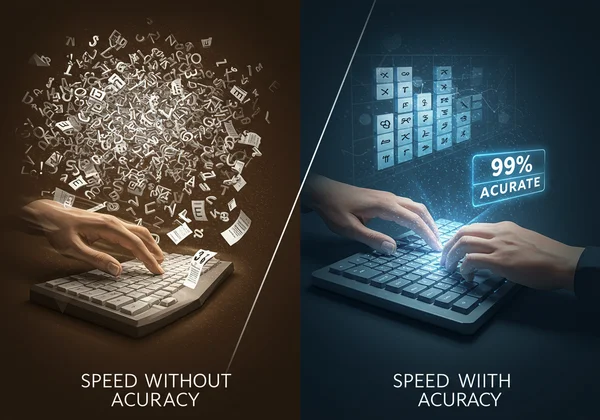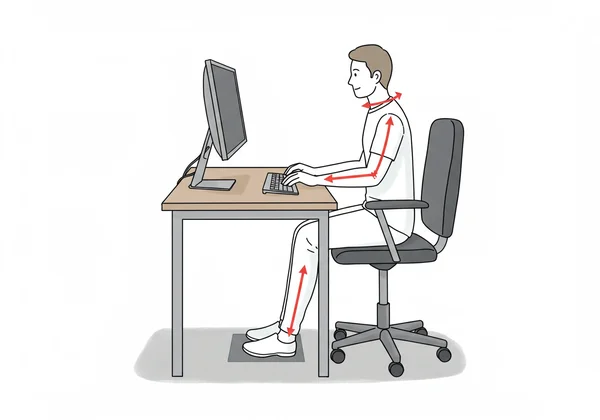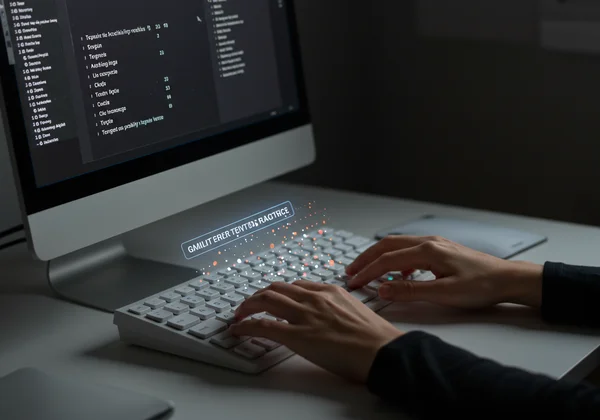Master Typing Accuracy: Boost Your WPM Test Score & Reduce Errors
Are frustrating typos and the constant need to hit backspace slowing you down? In the race for higher Words Per Minute (WPM), many of us forget the most crucial element of efficient typing: precision. Think of pinpoint typing accuracy as your secret superpower. It's the key to truly boosting your productivity, enhancing your professional image, and laying an unshakeable foundation for raw speed. But how can I test my typing speed and accuracy to start improving? This guide will show you why accuracy is your most important metric and provide a clear path to achieving a near-perfect score.
The journey to flawless typing begins with understanding your current skill level. Before diving into techniques, it's essential to establish a baseline. You can measure your accuracy on a free and intuitive platform that provides instant feedback without any registration. This initial step is critical for tracking your progress.

Why Typing Accuracy Matters More Than Raw Speed
Chasing a high WPM score without focusing on precision is like building a fast car with a faulty steering wheel—you’ll move quickly but end up in the wrong place. Real typing efficiency isn't just about speed; it's about hitting every key correctly the first time. Accuracy is the absolute cornerstone. For students, professionals, and even casual typists, prioritizing accuracy saves time and builds credibility.
The Hidden Costs of Frequent Typing Errors
Every typo carries a hidden cost. It’s not just the single incorrect character; it’s the time spent recognizing the mistake, moving the cursor, deleting the error, and retyping the word correctly. These micro-seconds add up significantly. For a professional, sending an email with errors can undermine their credibility. For a student, a typo-ridden essay can lead to a lower grade. Learning to proofread your work is essential, but preventing errors in the first place is far more efficient.
Speed Without Accuracy: A Flawed Strategy
A high WPM score is meaningless if it’s paired with low accuracy. Most typing tests calculate an "Adjusted WPM," which penalizes you for errors. A typist hitting 80 WPM with 90% accuracy is actually less productive than someone typing at 60 WPM with 99% accuracy. The fast but sloppy typist spends a significant portion of their time on corrections, erasing their speed advantage. The goal isn't just to type fast; it's to type correctly the first time.

Identifying & Reducing Common Typing Errors
To reduce typing errors, you first need to understand the kind of mistakes you’re making. Are you swapping letters, skipping them, or hitting adjacent keys by mistake? Once you identify your patterns, you can begin targeted practice to eliminate them. This diagnostic approach is the fastest way to improve.
Common Typo Types: What Mistakes Are You Making?
Most typing mistakes fall into a few common categories. Understanding them helps you become more mindful during practice.
- Transposition Errors: Swapping the order of two letters (e.g., typing "teh" instead of "the"). This often happens when your fingers are moving faster than your brain is processing the word.
- Omission Errors: Leaving a letter out entirely (e.g., "leter" instead of "letter"). This can be a sign of a poor typing rhythm.
- Substitution Errors: Hitting an adjacent key by mistake (e.g., "webt" instead of "went"). This usually points to improper finger placement or a need to improve keystroke precision.
- Insertion Errors: Adding an extra letter that doesn't belong.
Leveraging Our Platform's Feedback for Error Analysis
This is where a great tool becomes your best coach. When you take a free WPM test, you get more than just a final score. Typing test platforms like ours provide real-time feedback, often highlighting incorrect characters in red as you type. This instant visual cue trains your brain to recognize mistakes immediately. After the test, a detailed report breaks down your WPM, CPM, and, most importantly, your accuracy percentage. Use this data to see if your error rate is improving over time and to identify which letters or words cause you the most trouble.
Foundational Techniques for Achieving 99%+ Accuracy
Achieving consistently accurate typing isn't about secret tricks; it's about building a strong foundation. Mastering the fundamentals will do more for your accuracy than any other strategy. These techniques retrain your hands and mind to work together seamlessly, making precision second nature.
Mastering Proper Finger Placement & Touch Typing Basics
The single most effective method for improving accuracy is learning touch typing. This technique involves placing your fingers on the "home row" (ASDF for the left hand, JKL; for the right) and typing without looking at the keyboard. Each finger is responsible for a specific set of keys. By committing this layout to muscle memory, you eliminate the need to hunt for keys, which dramatically reduces substitution errors and boosts your overall efficiency.
The Power of Slow, Deliberate Practice
It may sound counterintuitive, but to type accurately at high speeds, you must first practice slowly. When you focus on hitting each key correctly, even if it feels sluggish at first, you are building correct muscle memory. Rushing through practice sessions only reinforces bad habits and trains your fingers to make mistakes. Slow down, focus on precision, and let the speed come naturally as your accuracy solidifies.
Ergonomics: Setting Up for Error-Free Typing
Your physical environment plays a surprisingly large role in your typing accuracy. Poor posture or an uncomfortable setup can cause physical strain, leading to fatigue and more mistakes. Ensure your chair is at a comfortable height, your wrists are in a neutral position (not bent up or down), and your monitor is at eye level. Improving your keyboard skills is also about creating a sustainable and comfortable practice environment.

Advanced Strategies for Sustained Error Prevention
Once you have a solid foundation, you can move on to more advanced techniques for error prevention. These strategies are about refining your skills, improving focus, and developing a smooth, consistent flow that makes typing feel effortless and precise.
Developing Consistent Typing Rhythm & Flow
Expert typists don't just type fast; they type with a steady cadence. Instead of short bursts of speed followed by pauses and corrections, aim for an even, metronome-like typing rhythm. This consistency helps regulate your keystrokes and reduces the likelihood of transposition and omission errors. Think of it like playing a musical instrument—rhythm is just as important as hitting the right notes.
Mental Focus & Minimizing Distractions
Typing isn't merely a physical action; it's a mental one. When your mind wanders, your fingers often follow, resulting in frustrating mistakes. To improve accuracy, create a focused environment free from interruptions. Close unnecessary tabs, silence your phone, and dedicate a block of time solely to your practice. This mental discipline will translate directly into higher productivity and fewer errors in your daily work.
Targeted Practice with Difficult Character Combinations & Punctuation
Everyone has certain letter combinations or symbols that trip them up. Maybe it's words with double letters or complex punctuation used in coding. The platform's custom text feature is perfect for this. Instead of using random text, you can paste in material you need to master, whether it's legal terminology, scientific vocabulary, or lines of code. This targeted practice is one of the most effective ways to conquer your personal typing demons. You can try custom text practice to work on your specific weak spots.

Your Journey to Typing Mastery Starts with Accuracy
Speed is an exciting metric, but accuracy is the bedrock of true typing proficiency. By shifting your focus from "how fast?" to "how well?", you will build a skill that pays dividends in every area of your digital life. Remember to diagnose your errors, build a strong foundation with touch typing, and practice deliberately. Your journey to becoming a faster, more efficient typist begins with the pursuit of precision.
Ready to put these techniques into action and see where you stand? Take the WPM test now and start your journey toward 99%+ accuracy today.
Frequently Asked Questions About Typing Accuracy
What is a good WPM score if accuracy is paramount?
A good score is any WPM achieved with 98% or higher accuracy. A typist with 50 WPM at 99% accuracy is often more productive than one with 70 WPM at 92% accuracy because they spend virtually no time on corrections. Always prioritize accuracy above 98% before focusing on increasing your WPM.
How is WPM and accuracy calculated on online tests?
WPM (Words Per Minute) is typically calculated by taking the total number of characters typed, dividing it by 5 (the average length of a word in English), and then dividing by the test duration in minutes. Accuracy is simpler: it’s the percentage of correctly typed characters out of the total characters typed. For instance, on our typing test, this data is generated instantly upon completion.
Can practicing on our platform really improve my accuracy?
Absolutely. Consistent practice on a typing test tool helps in several ways. The real-time feedback trains you to spot errors instantly, the post-test reports help you track progress, and the ability to use custom text allows for targeted practice on your specific weaknesses. It provides the data-driven feedback needed for deliberate improvement.
How long does it take to significantly improve typing accuracy?
Improvement depends on the consistency and quality of your practice. With 15-30 minutes of focused, deliberate practice each day, most people can see a significant improvement in their accuracy—from below 90% to over 95%—within a few weeks. The key is consistent, mindful practice, not just mindless repetition. You can start improving today and see the results for yourself.